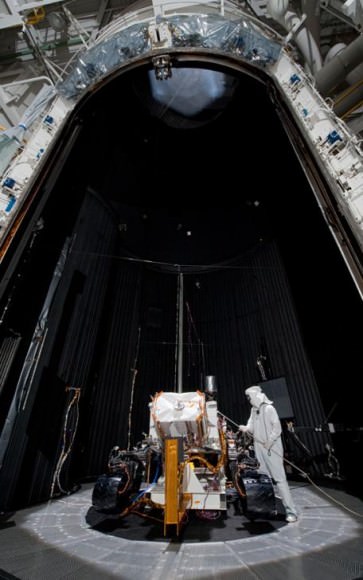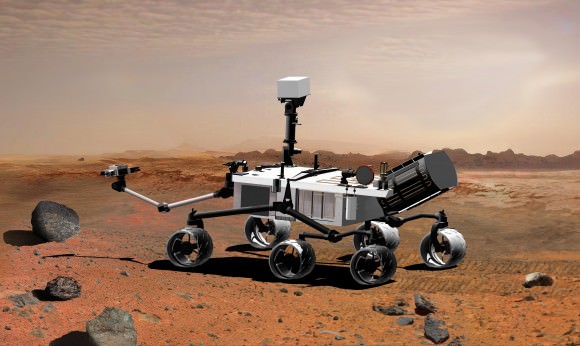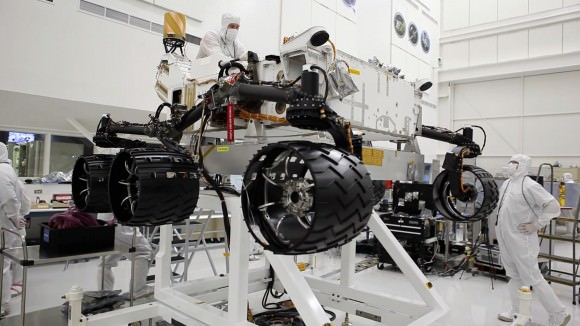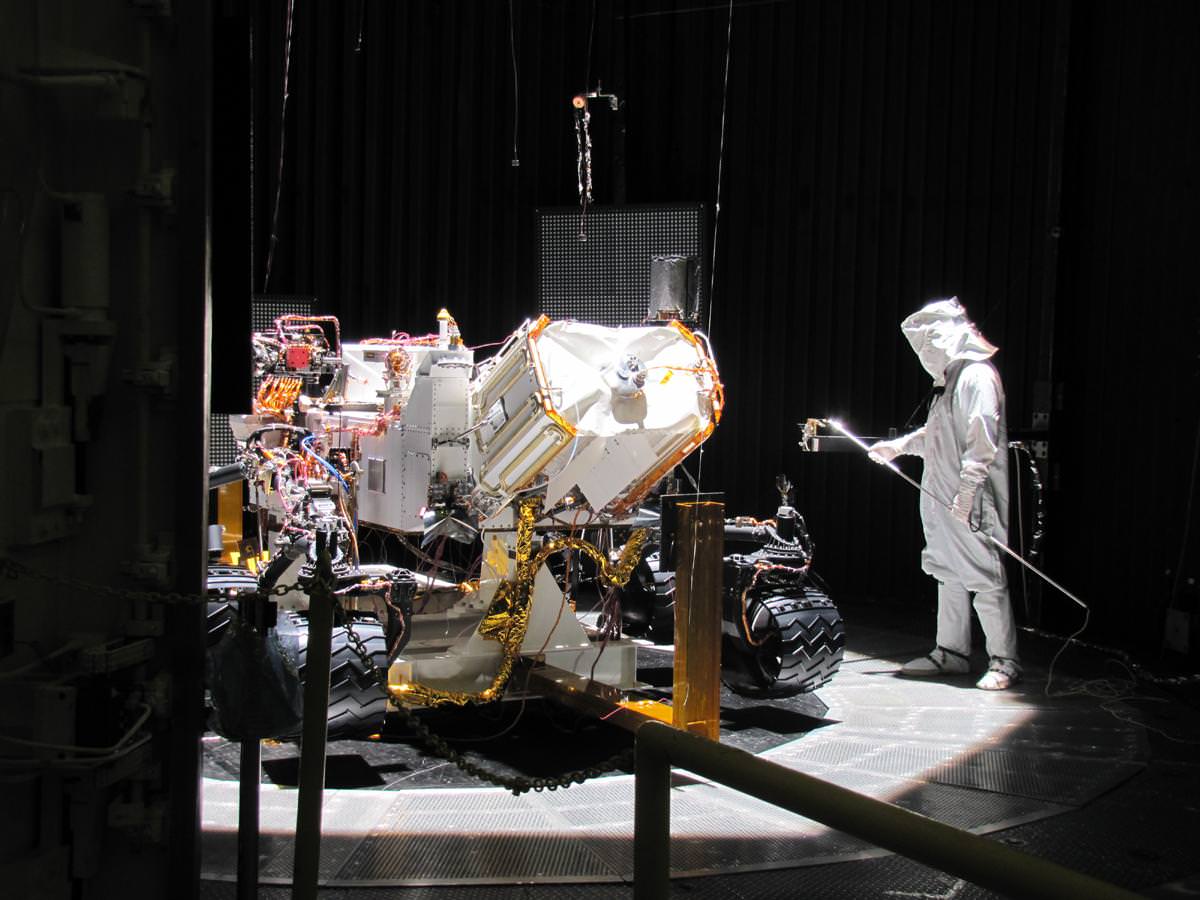[/caption]
NASA’s next Mars rover, named Curiosity, is now undergoing crucial tests that are designed to simulate the harsh environmental conditions of the Martian surface that awaits the rover when she lands there in August 2012.
Curiosity, also known as the Mars Science Laboratory or MSL, is the size of a mini-Cooper. It was placed inside a 7.6 meter (25 foot) diameter high vacuum chamber at NASA’s Jet Propulsion Laboratory. Engineers are now conducting an extensive regimen of tests that will check out the performance and operational capabilities of the rover under Mars-like conditions.

The internal chamber temperature was decreased to minus 130 degrees Celsius (minus 202 degrees Fahrenheit) using liquid nitrogen flowing through the chamber walls to approximate the Antarctic like bone chilling cold. Martian lighting conditions are being simulated by a series of powerful lamps.
Upon successful completion of the testing, all components of the MSL spacecraft system will be shipped to the Kennedy Space Center for final integration. This includes the cruise stage, descent stage and back shell.
The launch window for MSL extends from Nov. 25 to Dec. 18, 2011 atop an Atlas V rocket from pad 41 at Cape Canaveral, Florida.
MSL will land using a new and innovative sky crane system instead of airbags. Using the helicopter-like sky crane permits the delivery of a heavier rover to Mars and with more weight devoted to the science payload. Indeed the weight of Curiosity’s science payload is ten times that of any prior Mars rover mission.

MSL also features a precision landing system to more accurately guide the rover to the desired target than past missions, to within an ellipse about 20 kilometers long. After extensive evaluation, four landing sites where water once flowed have been selected for further evaluation. The final decision will come sometime in 2011.
Curiosity is about twice the size and four times the weight compared to NASA’s Spirit and Opportunity Mars Explorations Rovers which landed on Mars back in 2004. Opportunity continues to stream back science data from Mars after seven years. The fate of Spirit is unknown at this time as the plucky rover has been out of contact since entering hibernation in March 2010.
The science goal of Curiosity is to search the landing site for clues about whether environmental conditions favorable for microbial life existed in the past or even today on Mars and whether evidence for life may have been preserved in the geological record.
The rover is being targeted to an area where it is believed that liquid water once flowed and may be habitable. In particular the science teams hope to sample and investigate phyllosilicate clays, which are minerals that form in neutral watery conditions more favorable to the formation of life compared to the more acidic environments investigated thus far by Spirit and Opportunity.



An awesome name for an awesome mission. Glad NASA is going to Mars again, and with a better rover at that. Does anyone know what science it will be doing exactly (i.e. rock sampling; looking for certain minerals, drilling, etc.)?
Wikipedia has a brief summary of the science mission on their ‘Mars Science Laboratory’ page.
At the first image, the last line of the caption reads:
Yeah, but there never seems to be any shortage of funds for Tomahawk cruise missiles to launch against tin-pot dictators like Colonel Muammar Gaddafi!
(Sorry for the political rant, but it needed saying!)
If there were oil on Mars, we’d be launching volley’s of rovers there. Which reminds me.. has anyone figured out how to use ‘blueberries’ for fuel?
Yep – those puppies are $1 Million a pop, and they just fired off a volley of a hundred or more. Of course, that’s chump change compared to what they’re spending on all the other wars they’re fighting, but hey… ‘watch the 100’s of millions of $ and the 10’s of trillions of $ take care of themselves.’ I think the saying goes something like that…
I say we garnishee Gadhafi’s offshore accounts to pay for it.
Out of curiosity I searched and found this:
Primary Function: Long-range subsonic cruise missile for striking high value or heavily defended land targets.
Contractor: Raytheon Systems Company, Tucson, AZ.
Date Deployed: Block II TLAM-A IOC – 1984
Block III – IOC 1994
Block IV – IOC expected 2004.
Unit Cost: Approximately $569,000 (FY99 $).
Propulsion: Block II/III TLAM-A, C & D – Williams International F107 cruise turbo-fan engine; ARC/CSD solid-fuel booster.
That’s 100% inflation in ~10 yrs. No wonder we are broke!!!
Greed has put this country in the toilet, damn deep pocket robbers. All of them!!!
There should be a law dictating that for every 5 satellites looking down, one must look up. For every 10 LEO payloads, there must be a Mars payload. You know, like car fleet mileage requirements. Tie the NASA budget as a fixed percentage of DOD budget. Also, I want world peace, but that would interfere with the whole NASA-DOD idea.
Its quite interesting to see the detail they go to in getting the conditions exactly like Mars. An awesome piece of Engineering.
The only thing they cant simulate easily is the different gravity on Mars. It would be interesting to know how they tested the vehicle stability system with the different gravity involved.
I hope she doesn’t crash on the surface.
I agree with you hal9000. Eventhough the landing system looks cool, it will be a screecher……I think the past landing systems have worked well enough.
I think they should try too see and test here on Terra if the concept will work! I hope they use a radioactive sorce too generate power instead of solar. I am surprised that the 2 little rovers on Mars didn’t have some trouble with Meteorite hits on the solar panels.
Actually, the Mars Science Laboratory (Curiosity) will be powered by radioisotope thermoelectric generators (RTGs), as used by the successful Mars landers Viking 1 and Viking 2 in 1976.
Right. I think the only difference is the addition of the sky crane technique which will require less fuel to land the MSL compared with the Vikings.
Wikipedia is your friend:
“Landing a large mass on Mars is a difficult challenge: the atmosphere is thick enough to prevent rockets being used to provide significant deceleration, but too thin for parachutes and aerobraking alone to be effective.[72] Although some previous missions have used airbags to cushion the shock of landing, the MSL is too large for this to be an option.”
In effect, using chutes the MSL would go “rip … splat!”, using airbags it would go “poof … splat!” Take your pick.
The UT has webbed (netted) many excellent articles on the difficulty of landing on Mars such as this:
“The major conclusion that came from the session was that no one has yet figured out how to safely get large masses from speeds of entry and orbit down to the surface of Mars. “We call it the Supersonic Transition Problem,” said Manning. “Unique to Mars, there is a velocity-altitude gap below Mach 5. The gap is between the delivery capability of large entry systems at Mars and the capability of super-and sub-sonic decelerator technologies to get below the speed of sound.”
Plainly put, with our current capabilities, a large, heavy vehicle, streaking through Mars’ thin, volatile atmosphere only has about ninety seconds to slow from Mach 5 to under Mach 1, change and re-orient itself from a being a spacecraft to a lander, deploy parachutes to slow down further, then use thrusters to translate to the landing site and finally, gently touch down.”
Annoying. a) We can’t get to Mars (no developed fast enough vehicle that avoids disabling radiation doses) and b) we can’t get to Mars (no developed landing system for CEVs).
The JW telescope has a similarly compicated deployment system. That could foul up as well. One can only hope that things go according to plan with both of these.
LC
I want to see a Mars Race with all these rovers up.
Bummer that early carbonates are now known to be buried ~ 5-10 km down, because there is where life may have flourished. And here we are left scraping off the surface of later more biologically meager eras!
Agree but, not much chance of sending a drilling rig in the foreseeable future. lol
Otoh, maybe some of the deposits from the past water flows contain some of those early carbonaceous molecules picked up from canyons and craters etc..
@TLOM, just curious,
“Bummer that early carbonates are now known to be buried ~ 5-10 km down, because there is where life may have flourished.”
How was this determined?